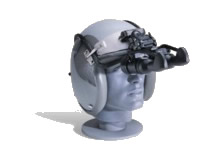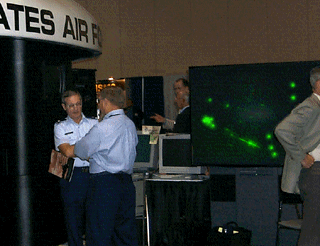Aechelon Technology and NVTS (AFRL/HEA) in collaboration with NAWCTSD demonstrated a new class of fully correlated physics-based NVG simulation. Based on Aechelon Technology’s C-Radiant, the system provided 1280×1024 60hz NVG simulated output using a state-of-the-art N-Vision HMD. The Head Mounted Display system uses the same optics and mounting mechanics as the deployed goggle.


In addition to the head tracked sensor image generation, a fully correlated OTW visible scene was also provided using a full field of view M2DART, with eight channels of 1700×1350 at 60hz for the periphery “out-of-goggle” view. This innovative system represents a milestone in sensor simulation.

The system is fully geospecific and correlated per texel, per frame with the OTW scene in a 340x400nm OTW database in use in the DTM exercises. Integrated with a high fidelity F16C cockpit in the Air Force Research Lab booth, the system was demonstrated in public for the first time.
C-radiant architecture makes the sensor databases independent of the sensor type, allowing the real time definition of the spectrum and filter response as well as the desired Auto Gain and Noise Modeling. In this way the same database serves all sensors (NVG, FLIR, LLTV and prototype) as well as radar simulation solutions such as Camber’s.
The sensor independent database was processed using elevation data, aerial photography and multispectral/hyperspectral satellite imagery, determining characteristics and normals per texel at any resolution. Aechelon multispectral processing tools allow the creation of run time material/normal databases beyond the resolution of the source data/classification provider while keeping the accuracy of the physics-based simulation.
In real time the system re-computes PER FRAME and PER TEXEL at 60hz the solid angle integral of all radiance sources, supporting in this way dynamic radiance environments in addition to flares, explosions and true 3D non-compatible light halo effects. Also per frame, noise and autogain are supported at ANY resolution.
Typical performance for NVG is 1280×1024 at 60hz, including goggle spectral response, autogain and noise and special effects, such as true halos for non compatible lights. The diffuse reflectance, the dynamic radiance for different moon phases and the ambient was computed per frame and per texel at 60hz.
The same database can also be used for other sensors including diffuse + emissive + ambient (i.e. FLIR). Diffuse reflectance and/or solar loading can be also computed per frame / per texel for the actual spectrum response and user-defined dynamic floating-point solid angle defined radiance sources.
The database architecture affords direct import to major radar simulation systems without an intermediate conversion, thus maintaining absolute correlation. In this way lossy and costly exports to OpenFlight + DFAD are not necessary, avoiding the lose of information and maintaining in this way the highest density of aspect and material resolution in the industry for radar processors in addition to sustaining per texel correlation for OTW and all sensors.
The system is inherently geospecific allowing the creation of large gaming areas and the use of the trainer for sensor mission rehearsal with complete integration with DMT environments and ensured correlation of OTW, NVG, FLIR and radar.
US Air Force Research Lab Link
Other partners of the Night Vision Training Team are:
USAF, USN and USMC
AFRL/HEA and NAWCTSD
N-vision Inc.
Photon Research Associates
SGB Enterprises
Surface Data
Datacube
Silicon Graphics Inc.
Copywright 1998 Aechelon Technology Inc.

